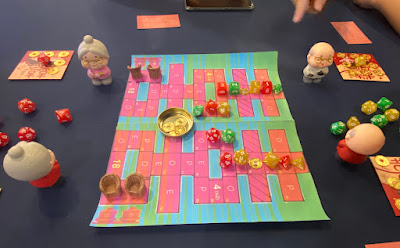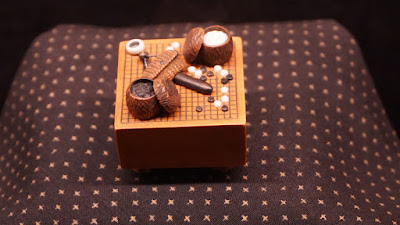Thursday, 30 January 2025
boardgaming in photos: working, playing and testing
Wednesday, 29 January 2025
Chatting Rivers and Lakes with Tao
Tuesday, 28 January 2025
Dungeon Roll
Friday, 24 January 2025
Rivers and Lakes
Tuesday, 21 January 2025
Finca
Friday, 17 January 2025
Hanamikoji
The Game
Hanamikoji is a 2013 game, so it's no longer a new game. I've heard many positive reviews, but only managed to give it a go recently. It is indeed a wonderful design. Succinct and clever. Hanamikoji is a 2-player card game in which you compete to win the favour of seven geishas by presenting them gifts.
Tuesday, 14 January 2025
Nine Tiles
Nine Tiles is from Japanese publisher Oink Games, but the designer is Jean-Claude Pellin from Luxemburg. The Sanrio characters version I have is not the first edition. The very first edition uses just generic abstract icons. There are six different icons in the game. It is an abstract game, and it is easy to paste any theme on it. There is a Disney version, a Chainsaw Man version, a Pokemon version, and even a Moomin version. It is a real-time game. A speed game. Players race to solve a puzzle and whoever is fastest scores a point.
Everyone has a set of 9 tiles. The tiles are double sided, and the characters on the two sides of a tile are different. Every character appears exactly three times, on three different tiles. You arrange your tiles in a 3x3 grid. When a round starts, you flip over the top card from the deck, and everyone races to change their own grid to look exactly like what the card specifies. This is all done in real time. You can flip your tiles and swap their positions. Whoever is first to make their grid look exactly like the card claims the card. You keep going until you run out of cards, and whoever has won the most cards wins the game. So the rules are super easy. However making the combination is not always easy. The pattern may require two Hello Kittys, but you are not exactly sure which two. You likely need to do much trial and error to figure out which side of each tile you need to use, to create the required combination.
I'd say this is mostly a children's game, because of the simplicity. It is easy for non gamers to learn too, and may entertain them for a while. For gamers this would be too simple, and it likely won't have much replayability. It's probably the kind of game you keep for those occasions when you bring games out for casual gamers and non gamers. It can also be a filler or opener for game night.
Sunday, 12 January 2025
Dancing Queen international edition coming soon from Matagot
Friday, 10 January 2025
Betakkuma's Fart & Furious
Betakkuma is a character from Japan. I know him from WhatsApp. I currently use a set of stickers based on him. I find them funny. Now this game Betakkuma's Fart & Furious was bought when I was at the 2024 Essen game fair in Germany. I bought it at the Thailand pavilion. The publisher is Thai, and they licensed the character for this game. A Japanese character in a Thai game sold in Germany. That's globalisation!
When I was at Essen, the Thailand pavilion was impressive. They had many designers and publishers, and also many games. Seeing our neighbouring country do so well was an encouragement for us Malaysian designers and publishers. Fart & Furious caught my attention because of the character. After listening to the brief description, I didn't immediately buy a copy. It is a party game about farting in the lift (elevator). That's a hilarious premise. I put it on my potential list. I was conservative about buying games because I didn't want to go over the weight limit. My plan was other than those I was determined to buy, I'd put games on the potential list, and I'd decide only by Sunday afternoon, the last day of the fair, which ones to buy. Now this was a little risky, because some games sold out early. Thankfully when I went back to the Thailand pavilion to get Fart & Furious, it was still available.
The Game
This is a simultaneous action selection party game. Every round you pick a card to play, and everyone reveals their card at the same time. You only have five cards. When you play a card, it stays on the table. You only get all your cards back into your hand after having played them all, or when you successfully play the exit card (to exit the lift). If you are willing to spend the effort to remember what cards have been played, you will know what cards your opponents still have in hand.
The three simplest cards are fart, breathe and hold (your breath). If you fart and someone else smells it, you score points. If no one smells it, you lose points. If you breathe and no one farts, you score points. If someone does fart, you lose points. If you hold your breath and someone farts, you score points. Otherwise, you lose points. This is very much like rock paper scissors, and these actions all make sense. You try to guess what your opponents might play. You don't always have a good basis on which to make your guess. After some cards have been played, you will have more information to help you guess. If everyone has farted, you know you can safely take a deep breath.
One of the cards is the exit card, which means you are getting off the lift. Now the twist it this card only works if you are the only one trying to exit. If more than one person wants to exit, you all end up fighting at the door and no one gets out. If anyone farts, you all smell it (and lose points).
The last card is the focus card. It doesn't have any effect by itself, but it doubles the effect of the card you play next round. If you manage to score points, you score double that. If you lose points, you lose double too. An exit card paired with a focus card gives you priority over regular exit cards.





















































